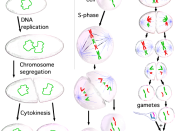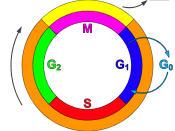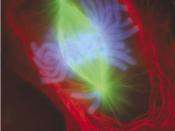The cell cycle is the life of a cell from the time it is first formed from a dividing parent cell until its own division into two cells. Cell division involves the distribution of identical DNA to two daughter cells. A dividing cell duplicates its DNA, allocates the two copies to opposite ends of the cell, and then splits into daughter cells. The replication and distribution of so much DNA is manageable because the DNA molecules are packaged into chromosomes. Eukaryotic chromosomes are made of chromatin. Each duplicated chromosome has two sister chromatids. In its condensed form, the duplicated chromosome has a center at a centromere. Mitosis, the division of the nucleus, is usually followed immediately by cytokinesis, the division of the cytoplasm. Where there was one cell, there are now two, each the genetic equivalent of the parent cell.
The mitotic (M) phase, which includes both mitosis and cytokinesis, is usually the shortest part of the cell cycle.
Interphase accounts for about 90% of the cell cycle. t is during interphase that the cell grows and copies its chromosomes in preparation for cell division. Interphase can be divided into subphases: the G1 phase ("first gap"), the S phase ("synthesis"), and the G2 phase ("second gap"). During all three subphases, the cell grows by producing proteins and cytoplasmic organelles such as mitochondria and endoplasmic reticulum. Mitosis is conventionally broken down into five stages: prophase, prometaphase, metaphase, anaphase, and telophase. The mitotic spindle, made of microtubules and associated proteins assemble and elongate. The assembly of spindle microtubules starts at the centrosome. During interphase, the single centrosome replicates, forming two centrosomes, which remain together near the nucleus. The two centrosomes move apart from each other during prophase and prometaphase of mitosis, as spindle microtubules grow out from them. By the end...


